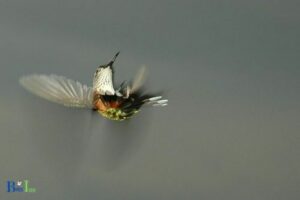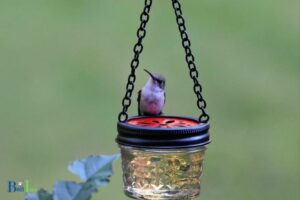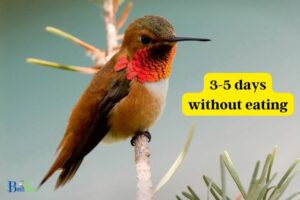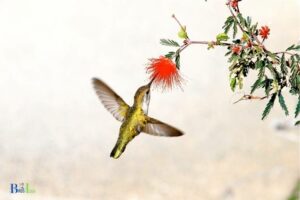When Do Hummingbirds Leave Idaho? September To October
Hummingbirds depart from Idaho during late summer and early fall, typically during September and October.
The exact timing of their departure is dependent on the temperature, weather patterns, and the birds’ individual migratory habits and genetics.

Hummingbirds migrate in order to find food sources and appropriate nesting areas to ensure their survival.
As the summer months come to an end, the birds start their journey hundreds of miles south, using the available resources in Idaho and along the way to fuel their long migration. Once the birds reach their destination, they will return the following spring.
DID YOU KNOW
The average hummingbird migrates about 1800 miles twice a year.
Why Do Hummingbirds Leave Idaho During Late Summer?
Hummingbirds typically migrate south to Idaho in the spring, and then leave during late summer. This is primarily due to a lack of food sources in Idaho during that time.
Hummingbirds depend on both nectar and insects for food, and in Idaho, many flowers and insects become scarce in late summer. Without access to these food sources, hummingbirds must look elsewhere for sustenance.

Additionally, late summer in Idaho can bring cold temperatures and storms, which can be dangerous for these small birds. To remain safe, hummingbirds make the decision to migrate south.
In conclusion, hummingbirds leave Idaho during late summer as there is a lack of food sources due to the changing season, and the cold temperatures and storms can be dangerous for them.
How Does Weather Affect the Timing of Hummingbird Departure from Idaho?
Hummingbirds migrate to warmer climates during winter to find food and more favorable temperatures. The timing of their departure from Idaho is heavily influenced by the weather.
Hummingbirds tend to leave in late summer or early fall when temperatures begin to cool. They use cues such as day length, temperature, and precipitation to determine when it is time to migrate. As the days get shorter and the temperature drops, they will fly south.

Heavy precipitation can also prompt the hummingbird to leave early. Rain or snow can make it difficult for them to find food sources, so they are motivated to migrate sooner.
In addition to weather cues, the age of the hummingbird also affects the timing of departure. Juvenile birds tend to migrate later in the season because they do not have the same experience as older birds.
Overall, weather can influence the timing of hummingbird departure from Idaho. Cold temperatures, short days, and heavy precipitation can all provide cues for the hummingbirds to leave in search of more favorable conditions.
“Hummingbirds, as magical as they appear, must also obey the laws of nature and migrate in search of a better life for themselves.”
birdsidea
What Are the Migration Habits of Hummingbirds?
Hummingbirds are migratory birds, capable of long-distance travel in order to find food and suitable nesting habitats.
Their migration habits vary by species, with some birds remaining in the same area year-round, and others undertaking long-distance migrations between seasonal habitats.

Migration Patterns:
- North American hummingbirds mostly migrate south for the winter, spending their summers in the north.
- Some species migrate as far as Central and South America, while others may only go as far south as Mexico.
- Long-distance migration is more common in western species than eastern species.
- Some hummingbirds migrate in large flocks, while others may go alone or in small groups.
Factors Affecting Migration:
- Weather and food availability determine when hummingbirds begin their migration.
- Hummingbirds migrate in response to environmental changes and food scarcity.
- Migration routes are determined by the availability of suitable nesting and feeding areas.
- Migration also depends on the availability of food sources and the presence of predators.
Hummingbirds have amazing migration habits, capable of travelling long distances in search of food and suitable nesting habitats.
By understanding the factors that influence their migration patterns and habits, we can better appreciate and protect these amazing creatures.
What Resources Do Hummingbirds Use in Idaho to Fuel Migration?
Hummingbirds use various resources during their migration through Idaho. These resources include:

Flower Nectar:
Hummingbirds rely on the nectar from flowers as a major source of energy and nutrition. Common flowers hummingbirds feed from in Idaho include columbine, penstemon, rhododendron, lupine, and thistles.
Insects:
Hummingbirds also feed on small insects like ants, mosquitoes, moths, and spiders. These insects are an important source of proteins and fats that hummingbirds need to fuel their long migration.
Water:
Hummingbirds will also consume small sips of water while they are on the move. The water helps to hydrate the birds and provides a small source of energy.
Tree Sap:
Hummingbirds also feed on tree sap, which is a great source of carbohydrates. They will often be seen perched on trees with sap oozing from the wounds.
Overall, hummingbirds utilize flower nectar, insects, water, and tree sap as resources in Idaho to fuel their migrations.
These resources provide them with the energy and nutrition they need to complete their long journeys.
Where Do Hummingbirds Stopover During Migration?
Hummingbirds make migratory journeys between their breeding and wintering grounds every year. During their migration, they make multiple stopovers to rest and refuel.
Commonly, hummingbirds stopover in wooded habitats, typically close to sources of water such as streams and rivers.

Hummingbirds also stopover in open habitats such as grasslands, fields, and parks. They also prefer areas with plenty of flowers, providing them with nectar-rich food sources. Generally, hummingbirds stopover for a day or two before continuing on their journey.
The following are some of the places where hummingbirds commonly stopover during migration:
- Flower Gardens: Hummingbirds tend to stopover in flower gardens, especially during the early hours of the morning when the flowers are still fresh and full of nectar.
- Tree Tops: Hummingbirds often rest and roost in tree tops, especially during the night.
- Water Sources: Hummingbirds often stopover near water sources such as streams and rivers.
- Open Meadows: Open meadows are also attractive stopover locations for hummingbirds.
- Shrubs and Bushes: In wooded habitats, hummingbirds often pause in shrubs and bushes.
What Are the Benefits of Hummingbirds Migration?
Hummingbirds are among the most remarkable migratory birds known to man. Their annual cycle of migration brings immense benefits to the environment and the people who observe them.

Here are some of the main benefits of hummingbird migration:
Increased biodiversity: Hummingbirds move from one region to another in search of food and new habitats, increasing the diversity of bird species in the areas they inhabit.
Pollination: Hummingbirds are important pollinators, transporting pollen from one flower to another, which helps increase the reproductive success of plants.
Improved seed dispersal: Hummingbirds eat a wide variety of seeds, and they then disperse them in different areas, providing food sources for other animals.
Improved air quality: Hummingbirds are also important in controlling insect populations, which can help reduce air pollution.
Ecotourism: Many people enjoy watching hummingbirds in their natural habitats and are willing to pay for the privilege of doing so, which helps to support local economies.
Overall, hummingbird migration is an essential part of the world’s ecosystem, and its benefits to humans and the environment should not be overlooked.
How Do Hummingbirds Get Back to Idaho in the Spring?
Hummingbirds migrate back to Idaho each spring, relying on their instincts and the earth’s natural cues to guide them. This amazing feat of navigation is possible due to several factors:

- The birds have a strong sense of direction, which allows them to make the journey in a straight line.
- Hummingbirds also have a good memory and can remember the location of food sources from the previous year.
- The onset of spring triggers a hormonal response in the birds that compels them to make a return trip.
- The position of the sun, stars, and magnetic fields can also help the birds orient themselves on their journey back to Idaho.
Hummingbirds are truly remarkable creatures; their yearly migration in the spring is a testament to their navigational and survival skills.
FAQ
When do hummingbirds typically migrate away from Idaho?
What factors influence hummingbird migration away from Idaho?
How long do hummingbirds usually stay in Idaho?
Are there any special places that hummingbirds like to stay when in Idaho?
Are hummingbird sightings in Idaho more common in certain months?
Conclusion
The hummingbirds of Idaho migrate south each year, heading out between late summer and early fall depending on the conditions of their environment and the individual habits of the birds.
This remarkable journey is a necessary one, as the birds require new food sources and nesting spots to ensure their continued success.






